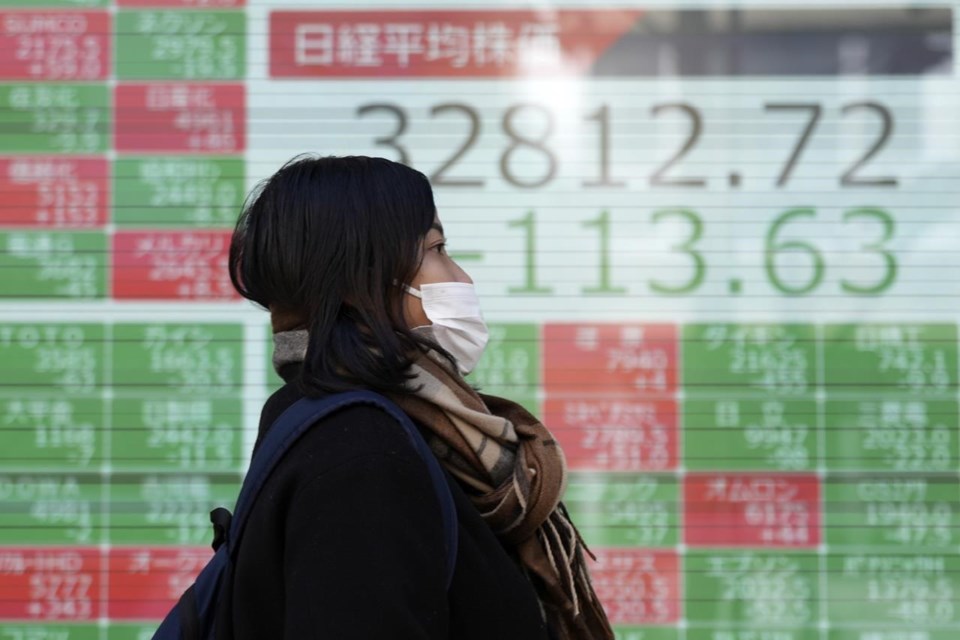BANGKOK (AP) — Shares are mostly higher in Asia after a powerful rally across Wall Street sent the Dow Jones Industrial Average to a record high as the Federal Reserve indicated that interest rate cuts are likely next year.
Tokyo’s Nikkei 225 fell, however, as the yen gained sharply against the U.S. dollar, since a weaker dollar can hit the profits of Japanese exporters when they are brought back to Japan.
The Nikkei lost 1% to 32,594.89 while the dollar slipped from about 145 yen to 141.42 yen, its lowest level in four months. The value of the dollar tends to mirror expectations for interest rates, which affect returns on certain kinds of investments.
Toyota Motor Corp.'s shares fell 4.2% and Sony Corp. lost 2.3%. Honda Motor Co. shed 5.2%.
Elsewhere in Asia, Hong Kong's Hang Seng index climbed 1.1% to 16,408.26 and the Shanghai Composite index was up 0.3% at 2,977.56.
A World Bank report forecast that the Chinese economy will post 5.2% annual growth this year but that it will slow sharply to 4.5% in 2024. The report said the recovery of the world's second largest economy from the setbacks of the COVID-19 pandemic was still “fragile.”
Australia's S&P/ASX 200 jumped 1.6% to 7,373.70 and the Kospi in Seoul advanced 1.1% to 2,536.94. India's Sensex was up 1.1% and the SET in Bangkok also gained 1.1%.
On Wednesday, the Dow jumped 512 points, or 1.4%, to 37,090.24. The S&P 500 rose 1.4% to within reach of its own record, closing at 4,707.09. The Nasdaq composite also gained 1.4%, to 14,733.96.
Wall Street loves lower rates because they relax pressure on the economy and goose prices for all kinds of investments. Markets have been rallying since October as investors began hoping that cuts may be on the way.
Rate cuts particularly help investments seen as expensive, lower quality or that force their investors to wait the longest for big growth. Some of Wednesday’s bigger winners were bitcoin, which rose nearly 4%, and the Russell 2000 index of small U.S. stocks, which jumped 3.5%.
Apple was the strongest force pushing upward on the S&P 500, rising 1.7% to its own record close. It and other Big Tech stocks have been among the biggest reasons for the S&P 500’s 22.6% rally this year.
The Federal Reserve held its main interest rate steady at a range of 5.25% to 5.50%, as was widely expected. That's up from virtually zero early last year. It's managed to bring inflation down from its peak of 9% while the economy has remained solid.
In a press conference Wednesday, Fed Chair Jerome Powell said its main interest rate is likely already at or near its peak. He acknowledged, however, that inflation is still too high. Powell said Fed officials don’t want to wait too long before cutting the federal funds rate, which is at its highest level since 2001.
“We’re aware of the risk that we would hang on too long” before cutting rates, he said. “We know that’s a risk, and we’re very focused on not making that mistake.”
Prices at the wholesale level were just 0.9% higher in November than a year earlier, the government reported Wednesday. That was softer than economists expected.
Treasury yields tumbled in the bond market. The yield on the 10-year Treasury dropped to 3.98% early Thursday from 4.21% late Tuesday. It was above 5% in October, at its highest level since 2007. The two-year yield, which moves more on expectations for the Fed, sank to 4.43% from 4.73%.
In other trading, benchmark U.S. crude oil gained 14 cents to $69.61 per barrel in electronic trading on the New York Mercantile Exchange. It picked up 86 cents to $69.47 on Wednesday.
Brent crude, the international standard, was up 25 cents at $74.51 per barrel.
The euro rose to $1.0904 from $1.0876.
___
AP Business Writer Stan Choe contributed.
Elaine Kurtenbach, The Associated Press




